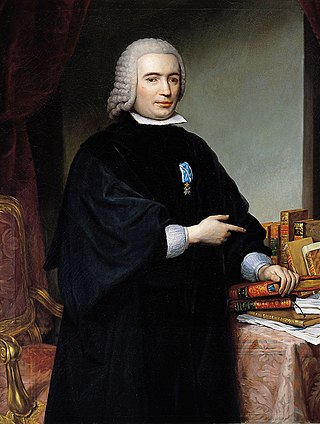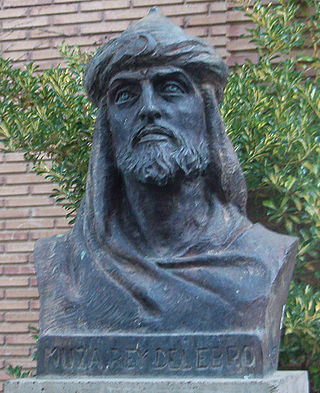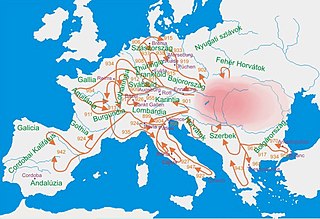Castile or Castille is a territory of imprecise limits located in Spain. The invention of the concept of Castile relies on the assimilation of a 19th-century determinist geographical notion, that of Castile as Spain's centro mesetario with a long-gone historical entity of diachronically variable territorial extension.

Alfonso IV, called the Monk, was King of León from 925 and King of Galicia from 929, until he abdicated in 931.
Ramiro I was king of Asturias from 842 until his death in 850. Son of King Bermudo I, he became king following a succession struggle after his predecessor, Alfonso II, died without children. During his turbulent reign, he fended off attacks from both Vikings and Moors. Architecturally, his recreational palace Santa María del Naranco and other buildings used the ramirense style that prefigured Romanesque architecture. He was a contemporary of Abd ar-Rahman II, Umayyad Emir of Córdoba.

Al-Hakam II, also known as Abū al-ʿĀṣ al-Mustanṣir bi-Llāh al-Ḥakam b. ʿAbd al-Raḥmān, was the Caliph of Córdoba. He was the second Umayyad Caliph of Córdoba in Al-Andalus, and son of Abd-al-Rahman III and Murjan. He ruled from 961 to 976.
Al-Mundhir was Emir of Córdoba from 886 to 888. He was a member of the Umayyad dynasty of Al-Andalus, the son of Muhamad bin Abd al-Rahman.

Pedro Rodríguez de Campomanes y Pérez, 1st Count of Campomanes, was a Spanish statesman, economist, and writer who was Minister of the Treasury in 1760. He was an adherent of the position that the state held supremacy over the Church, often called Erastianism. Campomanes was part of the government of Charles III. A staunch anti-Jesuit, one of the biggest foes of the order, Campomanes was the main driving force behind their expulsion.
Ruderick, better known by his Spanish name Rodrigo, was an influential noble of the Kingdom of Asturias, and was probably the first Count of Castile (850/862–873) and Álava (867/868–870). He was an active participant in the Reconquista and a faithful vassal of Ordoño I and Alfonso the Great, kings of Asturias. By conquering land from the Moors, Rodrigo began the southern expansion of the County of Castile.

TV Bailadores o TVCB es un Canal de Televisión Comunitaria en Bailadores, estado Mérida - Venezuela. Pertenece a una fundación sin fines de lucro llamada en la actualidad "Fundación de Medios Comunitarios de Bailadores" que engloba básicamente 3 medios de comunicación social: La Televisora (TVCB), Agrícola FM y Carú FM. Es la primera Televisora en el ámbito comunitario fundada en Venezuela.

Jerónimo de Alderete y Mercado was a Spanish conquistador who was later named governor of Chile, but died before he could assume his post.

Musa ibn Musa al-Qasawi (Arabic: موسى بن موسى القسوي also nicknamed the Great ; died 26 September 862) was leader of the Muwallad Banu Qasi clan and ruler of a semi-autonomous principality in the upper Ebro valley in northern Iberia in the 9th century.

Vela Jiménez who appears also as Vigila Scemeniz, is documented on two occasions as Count of Álava between 882 and 883 in the Codex Vigilanus, compiled in 881 with two large paragraphs added subsequently describing the events that took place in 882 and 883.

The Argentina Bicentennial was a series of ceremonies, festivals, and observances celebrated on May 25, 2010, and throughout the year. They commemorated the 200th anniversary of the May Revolution, a sequence of historical events that led to the Viceroy Baltasar Hidalgo de Cisneros being ousted from office and replaced with the Primera Junta, the first national government.
The Coro Nacional de Cuba is the national choir of Cuba. It was created in 1960 by Serafín Pro Guardiola as a continuation of the Coro del Ejército Rebelde that had been founded in 1959. It was initially called the Coro del Teatro Nacional and then Coro Polifónico, until recognition as the National Choir of Cuba. Since 1975 it has been led by the woman conductor Digna Guerra. The choir won Germany's Echo Klassik choral award in 2012.

A Hungarian raid in Spain took place in July 942. This was the furthest west the Hungarians raided during the period of their migration into central Europe; although, in a great raid of 924–25, the Hungarians sacked Nîmes and may have got as far as the Pyrenees.
Gonzalo Téllez was a nobleman who was Count of Lantarón and Cerezo and is also mentioned in a document dated 903 as Count of Castile. He and his wife were the founders of the Monastery of San Pedro de Arlanza.
Fruela was briefly the king of Asturias in 866 after usurping the throne from Alfonso III.
The Battle of Mollerussa took place in the south of the county of Urgell on 11 or 14 September 1102. In the battle, Count Ermengol V was defeated and killed by an Almoravid army. Mollerussa lies halfway between Bellpuig and Lleida and is the largest town in the Pla d'Urgell.
Rodrigo Cabral is an Argentine professional footballer who plays as a left winger for Argebtinos Juniors.
Al salir de clase is a Spanish teen drama television series produced by BocaBoca. The 1,199-episode-long broadcasting run on Telecinco spanned from September 1997 to July 2002.
El comisario is a Spanish police drama television series that originally aired for twelve seasons from 1999 to 2009 on Telecinco. Produced by BocaBoca and Estudios Picasso and starring an ensemble cast with the likes of Tito Valverde, Juanjo Artero, Elena Irureta, Marcial Álvarez, Jaime Pujol, Cristina Perales and Fernando Andina, among others, the plot tracks the daily life the members of the Cuerpo Nacional de Policía at the police station of San Fernando in Madrid.









